|
|
|
|
|
Galleria Tassonomica
di
Natura Mediterraneo
|
 Nota! La determinazione degli insetti necessita quasi sempre di un'indicazione geografica e temporale precisa. Nota! La determinazione degli insetti necessita quasi sempre di un'indicazione geografica e temporale precisa.
Invitiamo quindi gli utenti ad inserire questi dati ogni volta che viene richiesta una determinazione o viene postata una foto di un insetto. I dati forniti dagli utenti ci consentiranno anche di attribuire un valore scientifico alle segnalazioni, contribuendo a migliorare e integrare le attuali conoscenze sulla distribuzione delle specie postate.
|
|
| Autore |
 Discussione Discussione  |
|
|
paolofon
Utente Super
    
Città: Reggio nell'Emilia
Prov.: Reggio Emilia
Regione: Emilia Romagna

7483 Messaggi
Tutti i Forum |
|
|
paolofon
Utente Super
    
Città: Reggio nell'Emilia
Prov.: Reggio Emilia
Regione: Emilia Romagna

7483 Messaggi
Tutti i Forum |
 Inserito il - 02 gennaio 2011 : 21:07:09 Inserito il - 02 gennaio 2011 : 21:07:09


|
A) forse Andrena bicolor?
Ecco la descrizione del libro sopra citato:
| A. atra, villosa ; thorace, abdominis segmentis primis tribus parce
rufo-hirtis ; tibiis posticis tarsisque rufis, scopa fulva.
Female. Length 4 ½ – 5 ½ lines. Black; the face thinly clothed with
brown pubescence, the antennae nigro-piceous beneath ; the thorax
has a pale ferruginous pubescence, palest at the sides of the metathorax
and beneath ; wings subhyaline, their nervures ferruginous ;
the legs dark rufo-piceous, the posterior tibiae and the tarsi ferruginous; the
floccus pale fulvous ; the scopa fulvous, having a
golden lustre. The abdomen ovate, finely punctured ; the margins
of the basal segments thinly fringed with pale fulvous pubescence;
the apical fimbria fusco-ferruginous; the margins of the segments
beneath fringed with pale pubescence.
Male. Length 4-4 ½ lines. Black; the head rather wider than the
thorax, narrowed behind; the face covered with long dark fuscous
pubescence. Thorax clothed above with thin pale ferruginous
pubescence ; on the sides and on the legs it is cinereous ;
wings subhyaline, iridescent and slightly clouded at their apical margins,
the nervures testaceous ; the legs usually dark rufo-piceous, the
tarsi ferruginous. Abdomen oblong-ovate, with a thinly scattered
pale pubescence ; the apex acute and pale
|
La mia foto, dal giardino di casa, alla periferia di Reggio Emilia, il 21-03-2007.
Immagine:
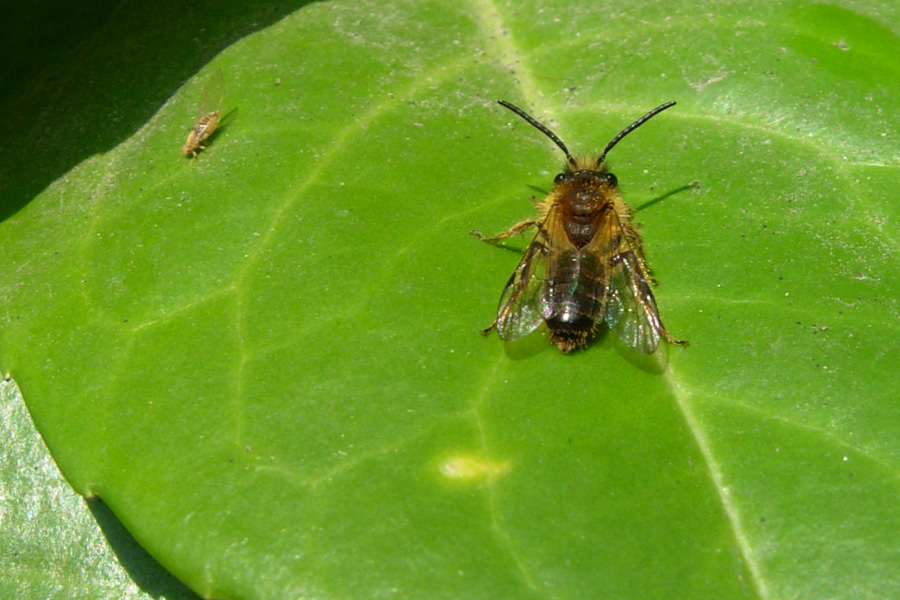
214,77 KB
Paolofon |
 |
|
|
paolofon
Utente Super
    
Città: Reggio nell'Emilia
Prov.: Reggio Emilia
Regione: Emilia Romagna

7483 Messaggi
Tutti i Forum |
 Inserito il - 02 gennaio 2011 : 21:11:31 Inserito il - 02 gennaio 2011 : 21:11:31


|
B) potrebbe essere Andrena carbonaria maschio?
| A. aterrima, glabra, abdomine nitido ; tibiarum posticarum scopa
subtus alba, supra fusca.
Female. Length 6-7 ½ lines. Black; the pubescence on the head
and thorax black ; the flagellum nigro-piceous beneath; the wings
subfuscous and having a dark cloud at their apical margins, the
nervures ferruginous ; the floccus on the posterior trochanters of a
yellowish white, the scopa silvery white beneath, above fuscous.
Abdomen ovate and shining, its apical fimbria sooty black.
Male. Length 5-6 lines. Very closely resembles the other sex,
the pubescence on the thorax inclining to griseous ; the abdomen
ovate-lanceolate, shining, and having a little sooty pubescence at
the apex ; legs black ; the claws ferruginous.
|
Borzano, prime colline reggiane, 10-04-10.
Immagine:
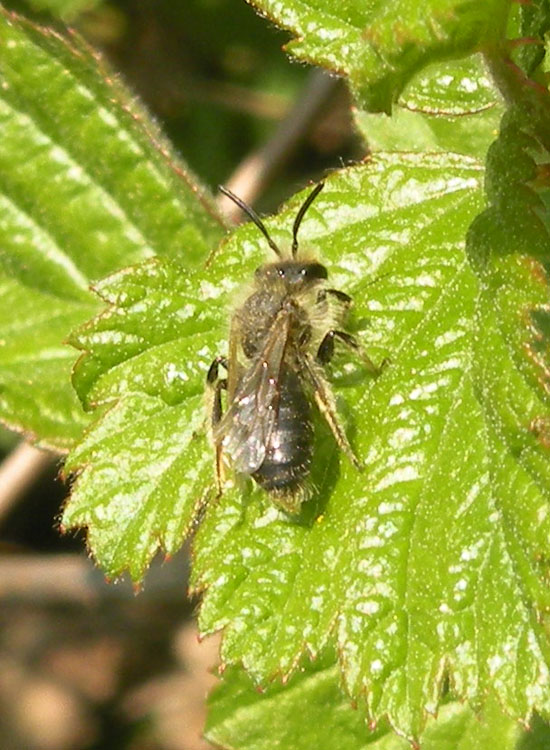
147,77 KB
Immagine:
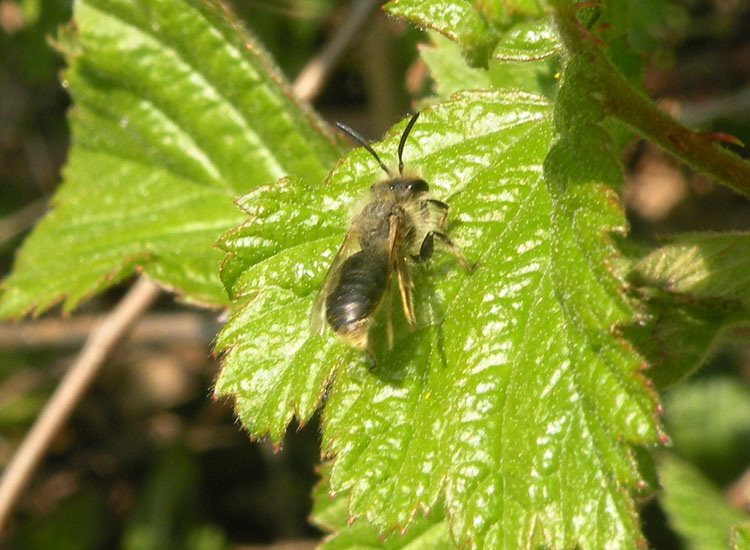
132,43 KB
Paolofon |
 |
|
|
paolofon
Utente Super
    
Città: Reggio nell'Emilia
Prov.: Reggio Emilia
Regione: Emilia Romagna

7483 Messaggi
Tutti i Forum |
 Inserito il - 02 gennaio 2011 : 21:18:16 Inserito il - 02 gennaio 2011 : 21:18:16


|
C) quest'Andrena bagnata dalla ruggiada assomiglia ad un maschio di Andrena haemorrhoea così come qui sotto descritto:
| A. nigra, albicanti subvillosa, thorace anoque ferrugineis hirtis,
tibiis posticis fulvis.
Female. Length 4-5 lines. Black; the face with thin cinereous pubescence;
a line of white silky pile at the inner margin of the eyes;
the clypeus strongly punctured. Thorax clothed above with ferruginous
pubescence ; wings hyaline, the apical margins slightly
clouded ; the tegulae and nervures rufo-testaceous ; the pubescence
on the metathorax and that beneath cinereous ; the intermediate
tarsi and posterior tibiae and tarsi fulvous ; their pubescence pale
fulvous ; the floccus on the posterior trochanters white. Abdomen
ovate, slightly shining, and closely punctured ; the apical fimbria
bright fulvous.
Male. Length 3 ½ —4 ½ lines. Closely resembles the female ; the
pubescence on the face more dense, longer, and inclining to fulvous;
the antennas as long as the thorax ; the posterior tibiae and tarsi
rufo-testaceous, the tibiae having a dark stain beneath ; the apical
joints of the other tarsi rufo-testaceous. Abdomen oblong-ovate,
with the apex fulvous.
|
Oasi di Bianello (RE), prima fascia collinare, 10-05-10.
Immagine:
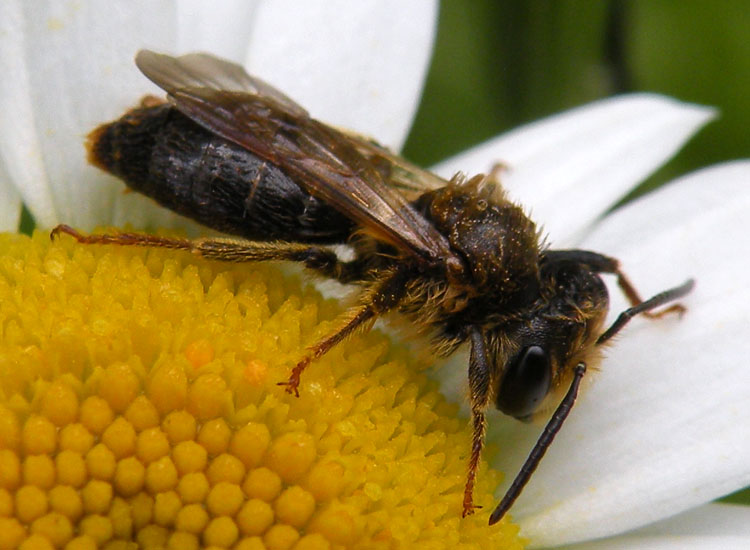
103,26 KB
Immagine:
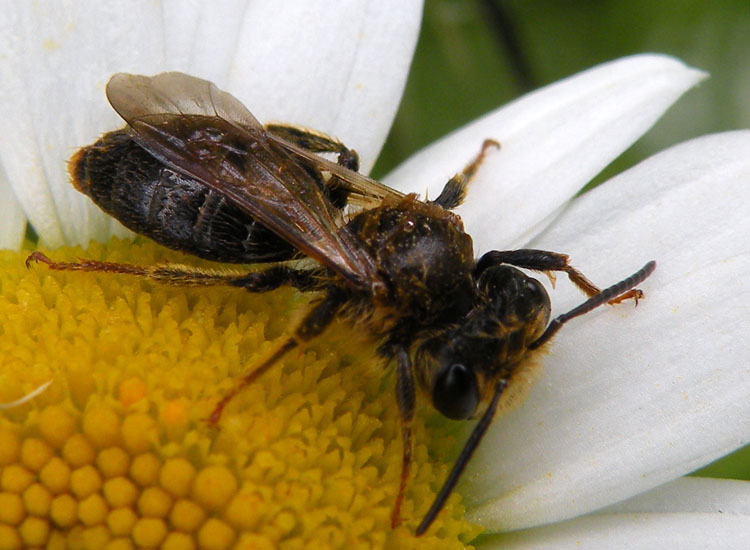
106,46 KB
Paolofon |
 |
|
|
uloin
Moderatore
    
Città: Alghero
Prov.: Sassari
Regione: Sardegna

7328 Messaggi
Fotografia Naturalistica |
 Inserito il - 03 gennaio 2011 : 19:40:32 Inserito il - 03 gennaio 2011 : 19:40:32


|
Ciao Paolo, delle numerose Andrena sono in grado di identificarne a colpo d'occhio soltanto alcune (poco più di una decina), non é il csso dei tuoi esemplari.
Per arrivare ad una determinazione utilizzando le chiavi dicotomiche per la maggior parte delle specie é un'impresa con l'insetto sotto al binoculare.
Già l'attribuzione ad una sottofamiglia si basa su tanti piccoli dettagli quasi mai visibili su fotografia (dentatuta delle mandibole, forma e punteggiatura del clipeo, del propodeo, proporzioni dei segmenti delle antenne e dei tarsi ecc...)
Posso solo dirti che la B non é certamente una carbonaria, questa ha l'addome nero lucente e la peluria del torace e delle pleure nera.
Saluti
Pietro |
 |
|
|
paolofon
Utente Super
    
Città: Reggio nell'Emilia
Prov.: Reggio Emilia
Regione: Emilia Romagna

7483 Messaggi
Tutti i Forum |
 Inserito il - 06 gennaio 2011 : 08:25:09 Inserito il - 06 gennaio 2011 : 08:25:09


|
Grazie, Pietro, delle tue giuste osservazioni! 
Gli imenotteri sono davvero difficili da riconoscere e per questo li osservo e fotografo mal volentieri. Però, scorrendo le gallerie di immagini di Internet, sono rimasto ammirato dalla loro varietà; come fare a conoscerli meglio?

Paolofon |
Modificato da - paolofon in data 06 gennaio 2011 08:25:52 |
 |
|
| |
 Discussione Discussione  |
|
|
|
 Natura Mediterraneo Natura Mediterraneo |
© 2003-2024 Natura Mediterraneo |
 |
|
Leps.it | Herp.it | Lynkos.net
|

 Forum
|
Registrati
|
Msg attivi
|
Msg Recenti
|
Msg Pvt
|
Utenti
|
Galleria |
Map |
Forum
|
Registrati
|
Msg attivi
|
Msg Recenti
|
Msg Pvt
|
Utenti
|
Galleria |
Map |